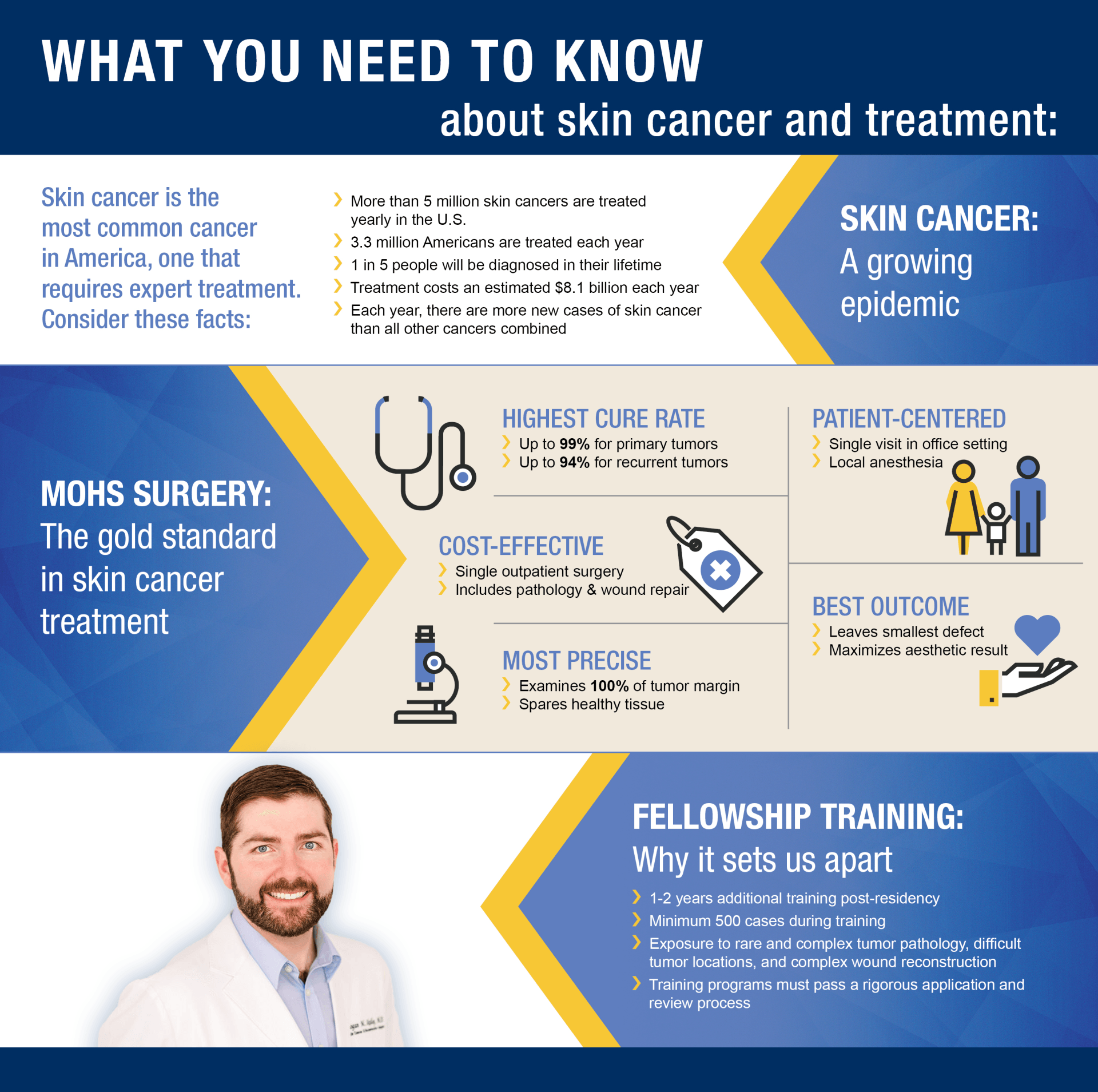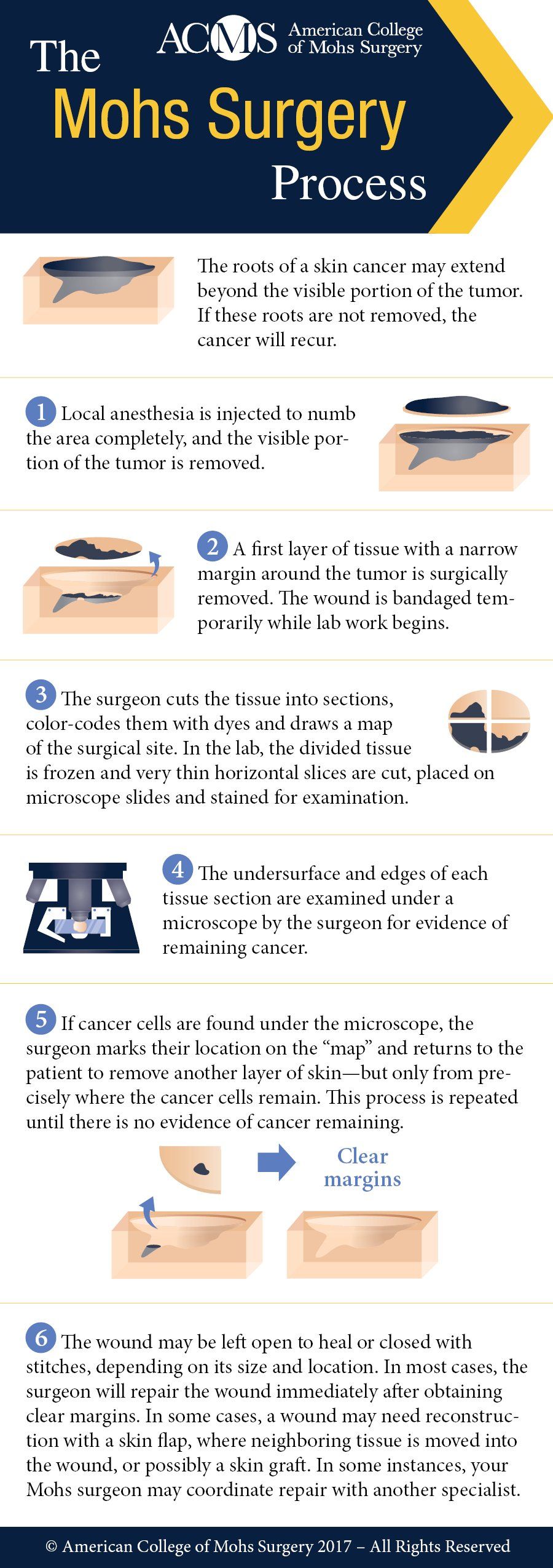Mohs Skin Cancer Surgery
Guardian Dermatology, P.C. | Helena, MT
What is Mohs Surgery?
Mohs Micrographic Surgery (MMS) or Micrographic Dermatologic Surgery (MDS) is a highly-specialized surgery utilized to treat certain types of skin cancer. The procedure is named after Dr. Frederic E. Mohs, who first pioneered the initial version of this technique in the 1930s.
Mohs Surgery has become the gold standard treatment for many forms of primary and recurrent skin cancers, including basal cell carcinoma (BCC), squamous cell carcinoma (SCC), and certain types of melanoma. It is a highly efficacious treatment for several rarer types of skin cancer as well. When indicated, MMS offers the highest cure rates and tissue conservation compared to any other skin cancer treatment modality.
Mohs Surgery combines the surgical removal of cancerous tissue with real-time pathologic interpretation to allow for complete margin assessment. The two-fold objective for this procedure is to thoroughly eliminate the skin cancer while simultaneously sparing as much healthy tissue as possible. Mohs Surgery is typically indicated when certain skin cancers are either very aggressive in nature or when they are located on high-risk areas of the body, such as the head, neck, hands, feet, or genitals.
Before your Mohs Surgery
You will meet with Dr. Skelley for a preoperative visit prior to your surgery day to discuss the nature of your skin cancer and the likely treatment approach. To prepare for your Mohs Surgery, you will need to inform our clinic of all medications and supplements you are taking. Our staff will coordinate with you before your procedure regarding your medications. Some medications or supplements may have to be suspended or altered temporarily to prevent complications during or after treatment. If you are taking prescribed blood thinners or anticoagulants, such as Aspirin, Plavix, Warfarin or the newer blood thinners, you should typically continue to take these medications prior to surgery.
While Mohs Surgery is an outpatient procedure, it is important that you set aside the entire day for your treatment. You should have no other appointments or obligations after your appointment time on the day of your surgery. Given the inherent nature of the procedure it is impossible to predict how long a patient may be at the office on the day of their surgery. Most skin cancers take at least a few hours to remove, and some skin cancers can take all day, depending on the size, location and complexity of the cancer. You should wear comfortable, casual clothing on the day of your surgery. Depending on your particular case, you may be asked to wear a surgical gown.
The Day of Your Procedure
On the morning of your surgery, you should take all of your regularly prescribed medications, particularly any blood pressure, blood thinners, or insulin that you normally take in the morning. Unless otherwise instructed, it is typically fine to eat and drink prior to your Mohs surgery. In fact, it is usually encouraged for you to have a light snack and to stay hydrated prior to your surgery.
Dr. Skelley will review your referring provider’s clinical photos, pathology report, and if available, your biopsy pathology slides prior to your surgery. In order to maintain our surgical schedule, Dr. Skelley will meet with you for a brief period prior to your surgery. If you need or desire more time to discuss your case with Dr. Skelley, we encourage you to schedule a pre-operative visit for that purpose.
At your surgical site, you will be given a local numbing injection to reduce any pain and discomfort associated with the surgical procedure. The site will then be cleaned and draped. The surgery will start with the removal of any visibly obvious tumor, or removal of the biopsy site if the area is well healed, along with a thin layer of surrounding and underlying tissue. A temporary bandage will be placed on the wound as the excised tissue is processed and taken to the lab. Once prepared, Dr. Skelley will examine your tissue under the microscope for any remaining cancerous cells. This part of the process typically takes the longest amount of time (~1 to 1.5-hour turnaround time).
If the first layer of tissue captures the entire skin cancer, we will then proceed to a discussion of repair options. If the first layer reveals residual cancer, we then proceed with taking another tissue layer (another ~1 to 1.5-hour turnaround time). This process of taking a tissue layer and checking it continues until the tissue is free of cancer or, rarely, a critical endpoint is encountered.
Once the cancer has been removed, we proceed with discussing various repair options for the resulting skin defect. Repair options can often range from simple (letting the wound fill in on its own) or side by side closure to complex surgical repairs. Every repair is discussed with the patient based upon mutually desired functional and cosmetic outcomes. Dr. Skelley has extensive reconstructive experience following skin cancer removal. He will work with you to determine the best possible repair or healing option for you in terms of function and cosmesis.
After the Procedure and Recovery
Any follow-up after your Mohs Surgery will depend on the extent of your surgery and the type of repair performed. If non-dissolvable stitches are used, we will coordinate how and when to have these removed. If dissolvable stitches or skin glue is used, we will review how to care for the wound. If you have questions or concerns at any point in your healing process, you are encouraged to contact the office. If you have an urgent concern outside of normal office hours, please seek care at a local Urgent Care or Emergency Department.
You will have a scar after your surgical treatment. However, every possible step is taken to reduce or hide your surgical scar following skin cancer removal. Occasionally, secondary procedures are needed, weeks to months after your procedure, to improve the appearance or functional aspect of your surgical site following skin cancer removal.
While Mohs Surgery has a very high cure rate, it is still important to keep your regular skin check appointments following your skin cancer treatment. This way we can ensure proper wound healing and assess for any signs of skin cancer recurrence.
Schedule an Appointment
Ready to schedule an appointment at Guardian Dermatology? Please call us at 406-272-5941 or click on the button below to get in touch.




